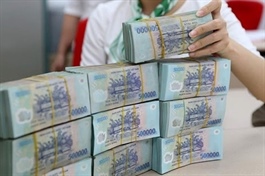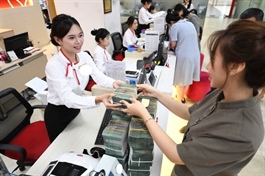Unlocking capital flows key to Vietnam's growth amid uncertainty
Unlocking capital flows key to Vietnam's growth amid uncertainty
To sustain high economic growth despite the current global uncertainties, Vietnam must unlock capital flows through credit, bonds, and equities. Industry experts outline ways to unlock these channels to meet the country's growth targets.

L-R: Nguyen Ba Hung, chief economist, ADB Vietnam, Nguyen Quang Thuan, chairman, FiinGroup, and Pham Thi Hoang Anh, deputy director, Banking Academy |
Nguyen Ba Hung, chief economist, ADB Vietnam
In 2024, Vietnam's economic growth momentum was primarily driven by its strong export performance and inflows of foreign direct investment (FDI). While domestic consumption remained stable, it did not fully support overall growth.
Vietnam's main anchor is the domestic economy, encompassing consumption and investment. Stimulus measures should focus on personal consumption, public spending, public investment, and creating a foundation to stimulate private investment.
Public spending and public investment are fiscal policies that Vietnam can actively implement, which will have a ripple effect, stimulating the domestic economy in the near future.
To stimulate growth, the government is aiming for an 8 per cent GDP increase this year, and double-digit rates from 2026 onward. Achieving this will require around $174 billion in investment, equal to 33.5 per cent of GDP, including $36 billion in public investment this year alone, up from $27 billion in 2024.
Private investment is expected to reach $96 billion, with $28 billion from FDI and $14 billion from other investment sources.
To mobilise more resources, the government may increase the budget deficit to about 4-4.5 per cent of GDP. Domestic demand stimulation will focus on public spending and investment to encourage private sector participation. This fiscal expansion can create strong spillover effects in the economy.
However, as global import demand declines, competition in export markets will intensify. Vietnamese businesses must enhance labour productivity and competitiveness to maintain their international market share.
Rising public investment and consumption, along with geopolitical tensions, could push inflation to 4 per cent in 2025 and 4.2 per cent in 2026. Although the State Bank of Vietnam (SBV) has set a target of 16 per cent credit growth this year, monetary policy has limited room to support the economy further due to inflation pressures, rising bad debts, and forex market volatility. Therefore, close coordination between monetary and fiscal policies is crucial for sustainable growth.
Nguyen Quang Thuan, chairman, FiinGroup
In a volatile economic environment, improved transparency and market integrity are essential. Corporate bonds are a key channel for medium- and long-term capital, but market instability has made businesses hesitant to issue new bonds.
Uncertainty over potential interest rate cuts in the US persists as inflation risks linger. If the Federal Reserve holds interest rates around 4.75 per cent, Vietnamese banks will face challenges in issuing international bonds.
FiinGroup’s credit rating of six major commercial banks reveals a critical issue – the shortage of long-term capital. With the SBV setting a 16 per cent credit growth target (or even up to 20 per cent), banks remain key funding conduits.
However, their limited share capital constrains lending growth. Raising long-term funds via equity or bond issuance can prove difficult, especially when deposit growth lags credit growth and the banking sector aims to lower deposit interest rates.
Capital adequacy is another concern. To buffer external shocks, including tariff-related risks, banks should increase their capital adequacy ratio from the current average of 11 per cent to 14–15 per cent in 2025.
Although Vietnam’s financial system has diversified funding sources, it still heavily relies on banks. Broadening capital sources and strengthening financial capacity is essential to reduce systemic risks in an unpredictable global landscape.
Pham Thi Hoang Anh, deputy director, Banking Academy
In addition to corporate bonds, the banking sector plays a leading role in medium- and long-term lending. The Prime Minister instructed the SBV to develop a preferential credit package worth VND 500 trillion ($20 billion) for science, innovation, and strategic infrastructure.
On April 24, the SBV coordinated with relevant ministries and four major state banks – Vietcombank, VietinBank, BIDV, and Agribank – to implement this $20 billion credit initiative. It is the largest-ever preferential credit package, directly supporting both traditional and emerging growth sectors.
Previously, the banking system had issued various targeted credit packages, but disbursement remains a major hurdle. Improving borrower access and clear lending criteria, particularly for medium- and long-term loans, is crucial to ensure success.
In addition to this package, the SBV launched a VND100 trillion ($4 billion) credit scheme on April 15, tailored to agriculture, forestry, and fisheries.
Its purpose is to boost production, reduce costs for farmers, and support cooperatives and small producers struggling with rising input prices and instability in trade policies of major partners.
Credit growth limits remain a key monetary tool to manage credit flows, prevent overheating, and safeguard macroeconomic stability. The SBV has actively used this mechanism and already allocated credit growth quotas to banks at the beginning of the year.
Unlocking capital channels, especially medium- and long-term funds, is vital for Vietnam’s growth ambitions. This requires coordinated efforts across public policy, banking, and capital markets.
Key priorities include improving transparency, enhancing bank resilience, stimulating domestic demand, and diversifying funding sources. With well-structured strategies and decisive execution, Vietnam can navigate uncertainties and maintain its growth trajectory.
- 18:13 28/04/2025

























